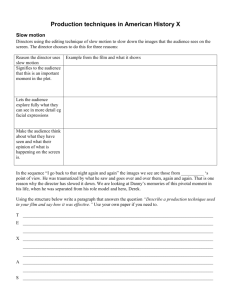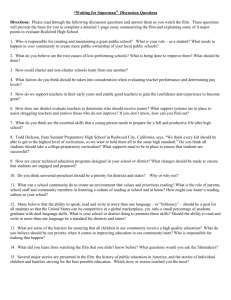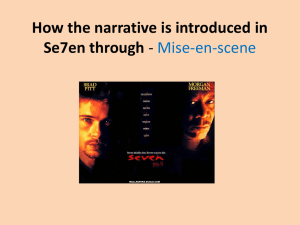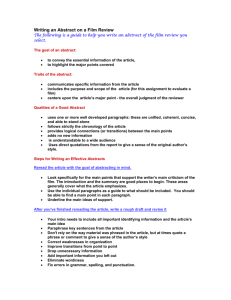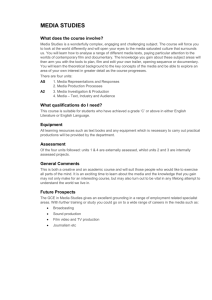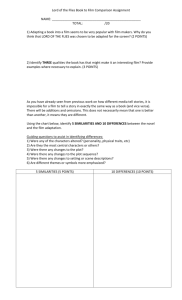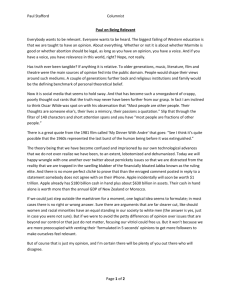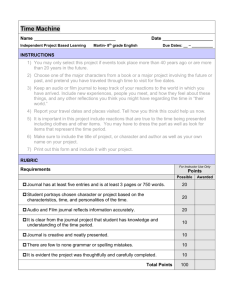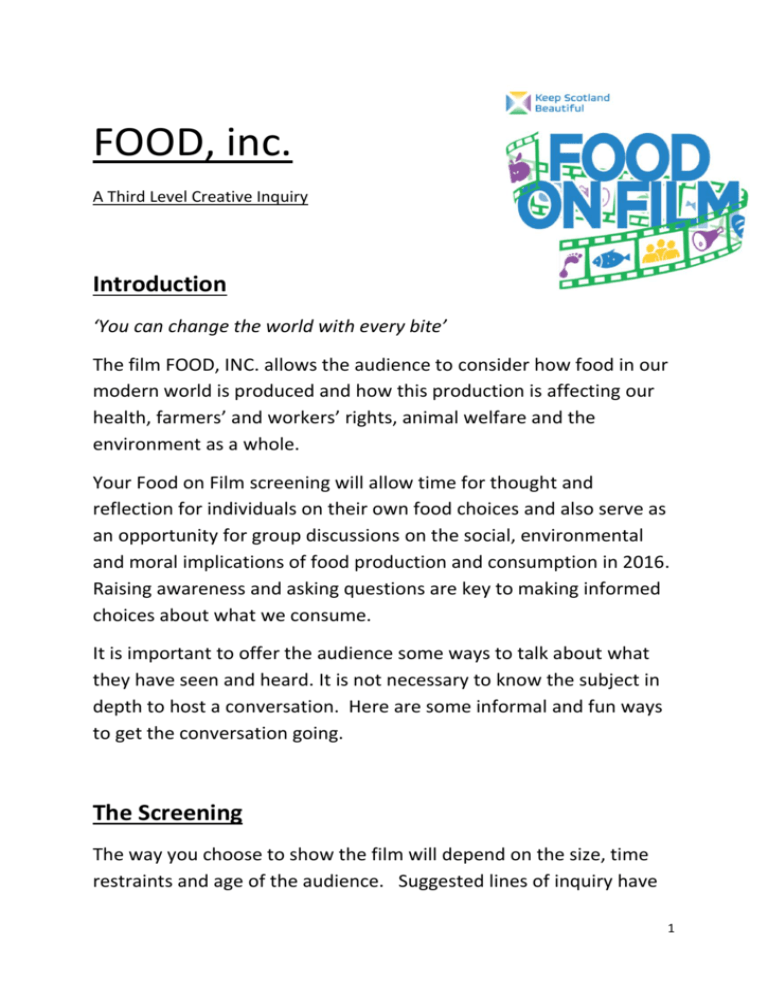
FOOD, inc.
A Third Level Creative Inquiry
Introduction
‘You can change the world with every bite’
The film FOOD, INC. allows the audience to consider how food in our
modern world is produced and how this production is affecting our
health, farmers’ and workers’ rights, animal welfare and the
environment as a whole.
Your Food on Film screening will allow time for thought and
reflection for individuals on their own food choices and also serve as
an opportunity for group discussions on the social, environmental
and moral implications of food production and consumption in 2016.
Raising awareness and asking questions are key to making informed
choices about what we consume.
It is important to offer the audience some ways to talk about what
they have seen and heard. It is not necessary to know the subject in
depth to host a conversation. Here are some informal and fun ways
to get the conversation going.
The Screening
The way you choose to show the film will depend on the size, time
restraints and age of the audience. Suggested lines of inquiry have
1
been split into the nine sections of the film. These can be presented
on a sheet for individuals to reflect upon as they watch the film and
then used as a basis for group discussions at the end or the film
could be stopped after each chapter and discussions could take place
throughout the showing of the film as best suits the audience. The
idea is that this is a flexible resource that can be adapted and used as
suits your audiences’ needs.
Before the film – Wee chats
Here are four ideas to use at the start of your screening to encourage
an atmosphere conducive to relaxed discussions at your event.
1) Food for Thought
Put a question on each seat to be discussed with shoulder partner.
Some possible questions are;
‘What did you have for dinner last night?’
‘What is your favourite meal?’
‘What is/was your parents/carers favourite meal?’
‘What and when was the last meal you made for yourself?’
‘What are your happiest food memories?’
‘Do any food smells remind you of a certain period in your life?’
2)Pensive Popcorn!
Similar to above but big tub/tubs of paper popcorn (scrunched up
paper) with statements/points for discussion that can be passed
around the audience.
2
3) Mapping activity
Have a large map either on a big screen or on the floor in the same
room as the screening. Place post it notes on chairs and on the
screen have the question, ‘What did you eat for dinner last night?’
People then write what they ate on post it notes and stick on the
map where they think the product was produced. This creates an
easy visual display of food miles.
4) Sustainable Development Goals Activity
One way to introduce the issues raised in the film is to look at the
Sustainable Development Goals and invite the audience to discuss
which goals are addressed in the film and ways in which they can be
overcome.
Pictures of all the 17 SDGs placed on chairs. Audience do a before
and after discussion about goals that they think will be/were
addressed in the film. Any surprises? Points for discussion?
Before/during/after the film
Lines of Inquiry (for the 9 sections of the film)
Fast Food To All Food
(12:52 minutes)
How often in the last month have you had food from a fast
food restaurant?
3
Why do you choose fast food –taste, speed, cost, seasonality,
peer pressure?
Do you think about how your food is produced?
Richard Lobb of the National Chicken Council states “In a way
we’re not producing chickens, we’re producing food.” Discuss
Should all animals have the same rights?
Should all farmers have the right to decide how they keep their
animals?
A Cornucopia of Choices
(7:54 minutes)
Reflect on the use of corn in the foods we eat. Brainstorm the
products that contain corn? How did you feel about this?
What does food choice mean to you?
Can you think of any problems in relying on just a few crops?
Is it your responsibility to know what is in your food or the
responsibility of other agencies?
Analyse your next meal to ascertain how many of your foods
contain products made from corn. There’s a list of corn derived
products in Appendix A
(This section shows a cow with a hole, or passageway, in its side called a fistula. The fistula connects
the cow’s stomach to the outside and is created to allow researchers to observe the digestibility of
foods in cattle.)
Unintended Consequences
(13:56 minutes)
Can you remember any recent food scares? What have been
the consequences and impact of these scares? What caused
them?
4
E. coli –Kevin’s mother says “Sometimes it feels like the
industry was more protected than my son” Discuss.
Are we right to assume our food is safe?
Is feeding cattle on corn a good idea?
The Dollar Menu
(5:13 minutes)
Does income affect what we eat?
What are the health implications of eating cheap processed
food?
Whose job is it to educate about healthy food choices?
How is fast food subsidized? Who does this benefit and what
are the costs?
Whose responsibility is it to ensure healthy food is accessible to
all?
In The Grass
(13:44 minutes)
This section shows footage of chickens getting killed and images of
slaughterhouses that some audiences might find difficult to watch.
You may want to alert your audience and/or provide another option.
Eduardo Pena says “We want to pay the cheapest price for our
food. We don’t understand that it comes at a price” What is the
true price that we are paying for cheap food?
Are workers’ rights being respected in the film? What can we,
as individuals do about it?
Author Michael Pollan says “Vote with your fork” to bring
about change. Discuss
5
Hidden Costs
(8:00 minutes)
Does it matter to you who produces your food?
Can you think of the effect on your food if small companies (like
the yoghurt company in the film) are bought over by big
companies?
Is cost the most important thing for our food industry? Is it the
most important thing for you? What about the environmental
costs of ‘cheap’ products?
Why are there more organic products in the large supermarkets
than there were five years ago? Do you believe the
supermarkets have had ‘moral enlightenment’?
Do you believe you can influence supermarkets by making
environmentally and ethically sound food choices?
From Seed to Supermarket
(10:07 minutes)
Should food labelling clearly show any genetically modified
products and ingredients?
How do you feel about eating genetically modified crops?
What are some of the advantages and disadvantages of a
company owning the patent for a seed?
Should a business dictate what an independent farmer can and
cannot do on his own land?
The Veil
(7:59 minutes)
When was the last time you read a label on food you were
about to consume?
6
Would information on a label put you off eating certain
products? Why?
Do you really want to know what is in your food or are you
happy to remain unaware?
Whose job should it be to regulate food labels?
Can we ever be sure the food we are eating is what we think it
is?
Is it possible to have a diet where we know exactly what we are
eating?
Shocks to the System
(7:08 minutes)
Can we as individual consumers make a difference to how the
world consumes food?
Have you tried to take control of your food choices? How?
What are the positive impacts of your choices?
It is too expensive for most to eat well and ethically in Scotland
today. Discuss.
How can we encourage people to think more about the food
they consume?
Do you actively support local, environmentally and ethically
sound food producers in Scotland? What difference does this
make?
7
After the film - Reflection
Here are some questions you can use after your screening to
encourage your audience to reflect on what they have seen and
heard.
Has ‘FOOD, INC’. changed the way you think about food?
Did anything in the film surprise you?
How often have you taken time to reflect on your food choices?
Is food production something you discuss with your family and
friends?
What is the most significant thing you have learnt through exploring
issues in ‘FOOD INC.’?
Are there any issues highlighted in the film that you would like to
explore further?
Do you feel confident expressing your own opinions about food?
Will you be making any changes to your own diet as a result of what
you have seen? Are you going to ‘vote with your fork’?
Did you work well with your team in the challenge? (for schools, as
below)
8
Key Challenge
Identify how issues raised in FOOD, INC. link in to the Sustainable
Development goals and devise a plan of action that can help to
address them.
OR
Create a three course menu using locally and ethically sourced
ingredients. You could make and taste some of these dishes at a One
Planet Picnic.
Through exploration of the key issues in FOOD, INC. pupils will be
enlightened and empowered allowing them to make informed
decisions about their own food choices and create a menu reflecting
what they have learnt.
Key Learning Focus
To explore the ethical, environmental and moral issues surrounding
food and food systems in the world today.
Learners will Evaluate the role of agriculture and different food production
systems in the production of food and raw material and draw
reasoned conclusions about the environmental impacts and
sustainability of food production.
Reflect on influences on the consumer and be able to
contribute to discussions on how consumers can be influenced
by external sources.
Critically analyse sources of evidence presented to inform own
opinion
9
Develop an awareness of the journeys which foods make from
source to consumer, their seasonality, their local availability
and their sustainability.
Taking Learning Further
Host a hungry for change One Planet Picnic
Explore marketing of foods and how this influences what we
consume.
Exploitation of workers. How do you know if you food was
produced by workers protected by employment legislation?
Different ways of shopping are emerging for example, farmer’s
markets, and online hubs that align consumers with producers.
Why are people shopping this way?
Looking Out For Learning
Head
I can understand how food is produced in Scotland.
I know where the food I eat comes from.
I understand that consumers can be influenced by external factors.
I have explored food production in different countries and can make an
informed opinion on what I have learnt.
I understand what is meant by genetically modified food and how this is
different to the processes of hybridisation.
Heart
I can make informed choices about what I eat.
I know the benefits of eating food that does not damage the environment, my
own health or people and places elsewhere.
10
I try to make food choices that will not adversely affect others.
Hands
I can source and cook with local and seasonal food.
I can grow different types of food plants.
I can contribute to discussions about food production in the UK and the wider
world.
I can support local farmers and food producers in the way I plan and consume
food.
CfE Experiences and Outcomes
When preparing and cooking a variety of foods, I am aware of the journeys
which foods make from source to consumer, their seasonality, their local
availability and their sustainability. HWB1-35a/HWB 2-35a
Having explored a range of issues which may affect food choice, I can discuss
how this could impact on the individual’s health. HWB3-34a/HWB 4-34a
Having investigated the effects of food processing on the nutritional value of
foods, I can critically assess the place of processed foods in a healthy balanced
diet. HWB 4-35a
By investigating different influences on the consumer, I can discuss how
consumers can be influenced by external sources. HWB 4-37a
I can apply my developing understanding of morality to consider a range of
moral dilemmas in order to find ways which could promote a more just and
compassionate society. RME 4-05 b
I can apply philosophical enquiry to explore questions or ethical issues. RME 409e
Having selected scientific themes of topical interest, I can critically analyse
issues, and use relevant information to develop an informed argument. SCN 420a
11
Having evaluated the role of agriculture in the production of food and raw
materials, I can draw reasoned conclusions about the environmental impacts
and sustainability. SOC 4-09a
Helpful previous experience/Prior Knowledge
I can share my developing views about values such as fairness and equality and
love, caring, sharing and human rights. RME 2-05b
When preparing and cooking a variety of foods, I am aware of the journeys
which foods make from source to consumer, their seasonality, their local
availability and their sustainability. HWB1-35a/HWB 2-35a
Through exploration and discussion, I can understand that food practices and
preferences are influenced by factors such as food sources, finance, culture
and religion. HWB 2-34a
I can explain how the different beliefs that people have, including beliefs which
are independent of religion, relate to their moral viewpoints and how this
leads them to respond to moral issues. RME 3-09c
Resources
FOOD, INC. –A film by Robert Kenner
Fast Food Nation- Eric Schlosser ISBN-10: 0141006870
The Omnivores Dilemma – Michael Pollan ISBN-10: 1408812185
Sustainable Development Goals https://sustainabledevelopment.un.org/
Resourceful cooking
http://resourcefulcook.com/mealplans/browse/forone
Seasonal Recipes
http://www.foodnetwork.co.uk/recipe/scottish-seasonal-recipes-februarykeyword.html?search=scottish-seasonal-recipes-february&section=recipes
How our favourite foods are made
http://www.bbc.co.uk/programmes/b05tymg8
Keep Scotland Beautiful is a registered Scottish charity. Number SC030332.
© Copyright Keep Scotland Beautiful 2016. All rights reserved.
12
Appendix A
Ascorbic acid
Baking powder
Calcium stearate
Caramel
Cellulose
Citric Acid
Confectioner’s sugar
Corn flour
Corn oil
Cornstarch
Corn syrup
Dextrin
Dextrose (glucose)
Diglycerides
Ethylene
Ethyl acetate
Ethyl lactate
Fibersol-2
Fructose
Fumaric acid
Gluten
Golden syrup
High fructose corn syrup (HFCS)
Inositol
Invert sugar
Malt
Maltodextrin
Margarine
Monoglycerides
Monosodium glutamate (MSG)
Polydextrose
Saccharin
Semolina
Sorbic Acid
Sorbitol
Starch
Sucrose
Treacle
Vanilla extract
White vinegar
Xanthan gum
Xylitol
13

